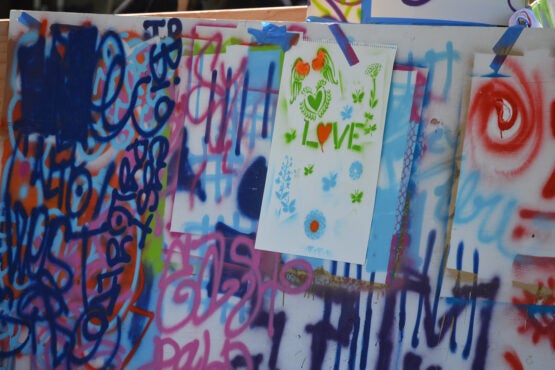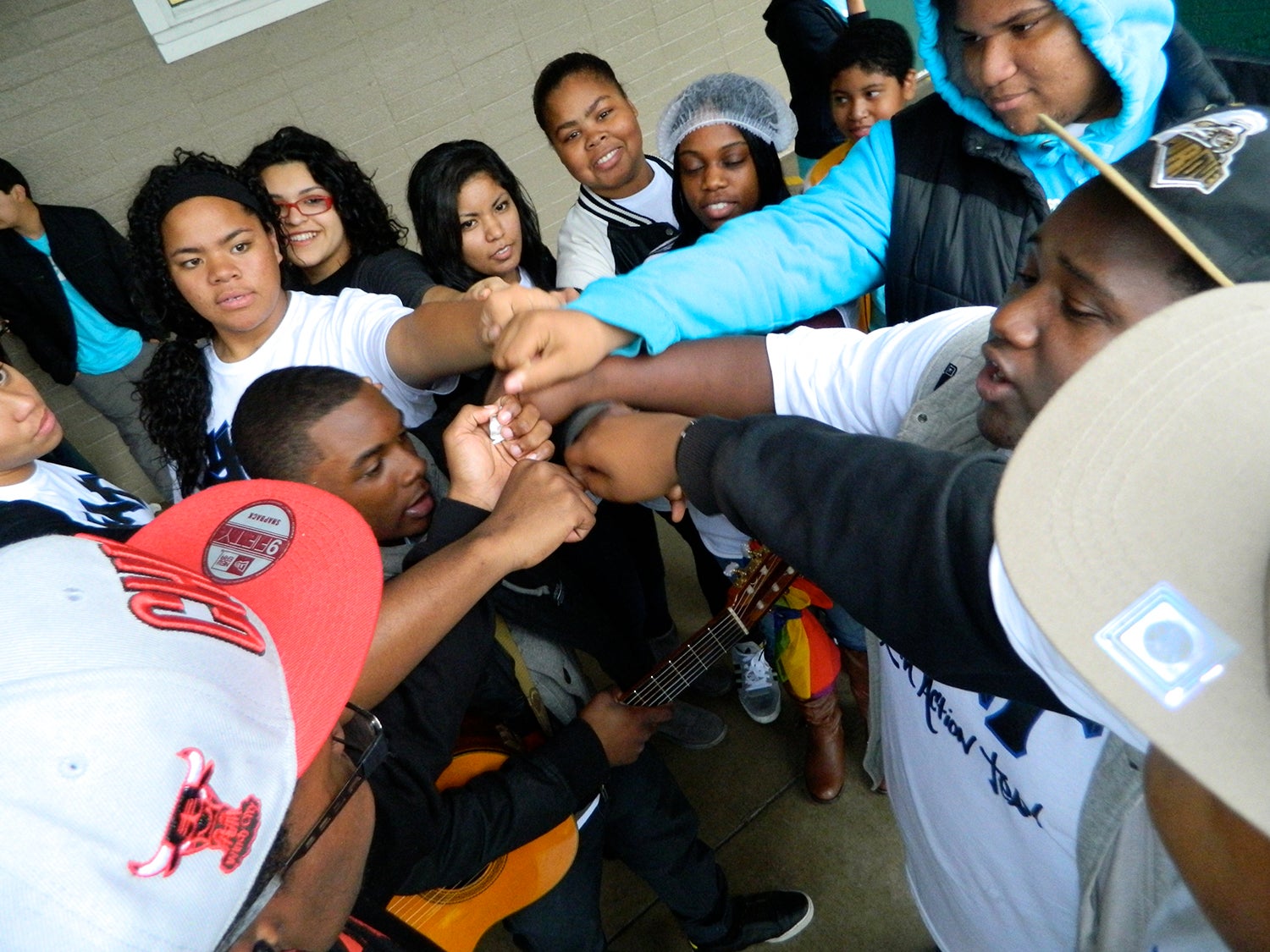Stanford deepens long history of supporting local students’ mental health and well-being
For decades, Stanford has engaged in school and community collaborations that support positive youth development, including efforts focusing on mental health and well-being.
For Michelle Griffith, having Stanford University’s support in developing a new mental health counselor program for the Redwood City School District feels like a “net underneath me,” she said.

Artwork featured during the 2013 East Palo Alto Art and Music Celebration, a partnership between Stanford Graduate School of Education’s John W. Gardner Center for Youth and Their Communities and the East Palo Alto community. (Image credit: Courtesy Gardner Center staff)
“They’ve been this incredible resource to guide us,” said Griffith, district director of community schools and partnerships. “I feel like they’re side by side with us and providing their expertise and experience to really move us forward in supporting our students and families.”
For years, Stanford has provided the school district with guidance in developing an appropriate model to respond to students’ diverse needs. This has included clinical expertise to strengthen individual strategies for student support and technical expertise on how the district can use data to inform continuous improvement. Stanford has also conducted research designed to better understand community needs and evaluate specific support strategies.
Stanford has engaged in school and community collaborations that support positive youth development for decades. Two partnerships out of the Graduate School of Education with the San Francisco Unified School District and elementary schools on the Peninsula, for example, facilitate sharing of research and practice to advance student achievement. Additionally, the Haas Center for Public Service and Stanford Medicine team up with the schools in the Ravenswood City School District to support reading development and healthcare, respectively.
Building on this, Stanford is supporting local school districts tasked with helping young people navigate trauma and the vulnerable period of adolescence as well as crises like suicide and the pandemic.
“We need to ensure we have early intervention models for youth to be really productive and vibrant young adults, to continue to take on these challenging times,” said Dr. Steven Adelsheim, clinical professor of psychiatry and behavioral sciences and director of the Stanford Center for Youth Mental Health and Wellbeing.
Meeting needs
The Graduate School of Education’s John W. Gardner Center for Youth and Their Communities, founded in 2000, aims to improve youth well-being through research-practice collaborations that inform policy and practice while emphasizing equity and capacity building in youth-serving organizations.
The interdisciplinary research team provides expertise in design and methods, schools and school districts, youth development, community engagement and education policy.
In one of its initial projects, the Gardner Center helped to successfully introduce the national concept of a community school model to more than a dozen Bay Area school districts, said center Executive Director Amy Gerstein. Under this model, districts work with a wide array of community partners to promote a child’s growth across multiple dimensions, including but not limited to academic development. Such a “whole child” perspective helps ensure that students and their families have access to the resources they need, including social services, health care and academic support.
Additional areas of early focus include youth leadership and capacity building in youth development.
Working with school districts, nonprofits and others, “our role historically in this area is to build our partners’ capacity to use research to improve practice and ultimately to improve youth experiences and outcomes,” said Gardner Center Research Associate Kristin Geiser.
Notably, the Gardner Center employs a community-engaged approach with positive youth development and whole child perspectives. This helps create settings in which every individual has the opportunity to receive resources, flourish and thrive, Geiser said.
“We are keenly aware that acute or sustained experiences of unmet needs have a real impact on the health and well-being of youth, their families and communities,” she said.
Making space
Established in 2015, the Center for Youth Mental Health and Wellbeing in Stanford Medicine’s Department of Psychiatry and Behavioral Sciences makes supportive mental health care accessible to youth and young adults ages 12 to 25, a critical period of youth development that’s often “underresourced and underappreciated,” said Program Director Vicki Harrison.
Community-based and youth-advised, the center focuses on school mental health and suicide prevention; community education and advocacy; and early interventions for mental health.
Two teen suicide clusters in Palo Alto during the 2008-09 and 2014-15 school years were among the first significant community issues the center focused on. Dr. Shashank V. Joshi, professor of psychiatry and behavioral sciences, with courtesy appointments in pediatrics and education, has long worked with schools on mental health, suicide prevention and response.
Shortly after the first suicide cluster, he helped create the Health Care Alliance for Response to Adolescent Depression (HEARD Alliance), which increases collaboration among health care professionals to enhance the community’s ability to promote well-being, treat depression and related conditions, and prevent suicide in adolescents and young adults. It also offers a free K-12 Toolkit for Mental Health Promotion and Suicide Prevention.
The center’s initiatives now include a wide range of work, such as:
- Media and mental health
- Youth-led anti-stigma awareness efforts
- Psychosis Risk and Early Psychosis Program (PEPPNET)
- Conferences, webinars and community events
- School and community partnerships
- allcove integrated youth mental health centers
“We’re really trying to build that whole continuum of support,” Adelsheim said. “For us, it’s been really important to come into a community and listen and see what the community needs and find ways to engage the community’s voice to provide services.”
Shared expertise
The Gardner Center began working with the Center for Youth Mental Health and Wellbeing a few years ago. One of their first collaborations was the San Mateo Area Teen Mental Health Study, funded by the Peninsula Health Care District, to determine what conditions were supporting and hindering the district’s ability to serve students.

Members of the East Palo Alto Youth Action Team, which was established through a partnership between the John W. Gardner Center for Youth and Their Communities and two East Palo Alto community-based organizations: Live in Peace and the Mural Music and Arts Project. (Image credit: Courtesy Gardner Center staff)
The study found many students are struggling with housing insecurity, with some checking Craigslist to try to help their parents find housing. Others face food insecurity or care for younger siblings while parents work multiple jobs.
The study also highlighted the importance of comprehensive continuity of care for the whole child. It’s not unusual for superintendents to call Gerstein for help on issues such as chronic absenteeism and educational outcomes of students who are English language learners.
“It’s really hard to put those systems in place when you don’t have enough resources in a school district,” Gerstein said.
An urgent pivot
When the pandemic began, it impacted the centers’ work “pretty dramatically,” Adelsheim said.
“We have to think about more support for young adults in terms of the grieving,” Adelsheim said, referencing loss of life or jobs, missed graduations and more.
In response, they have been facilitating youth-led community conversations around mental health and working on a school mental health screening tool to help identify students at risk and link them to services.
The impact of unmet needs on youth became compounded by prolonged isolation, anxiety and disruptions to developmentally appropriate opportunities for learning, growth and development, Geiser said.
The team has also supported teacher and staff well-being through webinars focused on a number of topics, including general guidance for returning to in-person instruction as well as more specific clinical support around the pivot to telehealth models, Joshi said.
“Students need to be healthy enough to learn, and that’s why schools need to be paying attention to the mental health needs of students, teachers and administrators,” Joshi said.
As thousands of people showed up for town halls on mental health, “it was really striking in terms of the urgency,” Adelsheim said.
Meeting the moment
The two centers are now working together on the Stanford Redwood City Sequoia School Mental Health Collaborative between Stanford, the Redwood City School District and the Sequoia Union High School District, a three-year effort to build district capacity to understand and address mental health needs of students and families.
The Department of Psychiatry and Behavioral Sciences is also conducting a new research project: Support, Help, Inspiration, Nurturance and Encouragement, or SHINE, with Milpitas High School and Mills High School in Millbrae to better understand the unique challenges facing Asian American families and particularly diaspora immigrant families in the Bay Area.
The Gardner Center recently released a second round of findings as part of the COVID-19 Community Needs Assessment conducted with Redwood City Together.
And Stanford faculty members are participating in the California Department of Education’s student mental health policy workgroup to help inform policy.
“Our work really does touch the local community, state and national levels,” Harrison said.
For Griffith, her coworkers, students and their families, Stanford’s support makes all the difference.
“It’s robust, it’s responsive, it’s proactive, it’s consistent, and the follow through has been amazing,” she said. “They’ve come in as a true partner and have been so open for us to share not only what we’ve already done but also our hopes for the future.”
